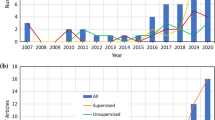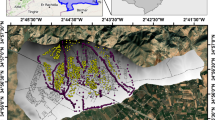Abstract
Site seismic hazard (SSH) is an integral component of seismic risk assessment of engineered structures. The SSH encompasses the effect of ground shaking, landslide, and liquefaction. Discernment of liquefaction and lateral spreading vulnerability is a complex and nonlinear procedure that is influenced by model and parameter uncertainty. In this study, nine different data-driven models were investigated to predict the lateral spread displacement over a free-face and ground-slope conditions. These models include: multivariate adaptive regression splines, generalized additive model, neural networks, generalized linear model, robust regression, regression tree, support vector machine, projection pursuit, and random forest. The results demonstrate efficacy of the proposed models for lateral spreading estimation and in general, the random forest showed a better prediction. Sensitivity analysis is also performed to identify parameters that contribute to the model variability.
Similar content being viewed by others
References
Abdoun T, Dobry R (2002) Evaluation of pile foundation response to lateral spreading. Soil Dyn Earthq Eng 22(9–12): 1051–1058
Bartlett SF, Youd TL (1992) Empirical analysis of horizontal ground displacement generated by liquefaction-induced lateral spreads. Technical report NCEER-92-0021, Brigham Young University, Provo, Utah
Bartlett SF, Youd TL (1995) Empirical prediction of liquefaction-induced lateral spread. J Geotech Eng 121(4): 316–329
Baziar M, Ghorbani A (2005) Evaluation of lateral spreading using artificial neural networks. Soil Dyn Earthq Eng 25(1): 1–9
Bird JF, Bommer JJ (2004) Earthquake losses due to ground failure. Eng Geol 75(2): 147–179
Bird JF, Bommer JJ, Crowley H, Pinho R (2006) Modelling liquefaction-induced building damage in earthquake loss estimation. Soil Dyn Earthq Eng 26(1): 15–30
Boone SJ (1996) Ground-movement-related building damage. J Geotech Eng 122(11): 886–896
Bradley BA, Cubrinovski M, Dhakal RP, MacRae GA (2010) Probabilistic seismic performance and loss assessment of a bridge–foundation–soil system. Soil Dyn Earthq Eng 30(5): 395–411
Breiman L (2001a) Random forests. Mach Learn 45(1): 5–32
Breiman L (2001b) Random forests. Technical report, University of California, Berkeley, CA 94720
Cabalar AF, Cevik A, Gokceoglu C (2012) Some applications of adaptive neuro-fuzzy inference system (anfis) in geotechnical engineering. Comput Geotech 40(0): 14–33
Chiru-Danzer M, Juang CH, Christopher RA, Suber J (2001) Estimation of liquefaction-induced horizontal displacements using artificial neural networks. Can Geotech J 38: 200–207
Duda RO, Hart PE, Stork DG (2001) Pattern classification, 2nd edn. Wiley, London
Faraway J (2002) Practical regression and ANOVA using R. http://cran.r-project.org/other-docs.html. Retrieved Jan 2012
Finn W, Fujita N (2002) Piles in liquefiable soils: seismic analysis and design issues. Soil Dyn Earthq Eng 22(9–12): 731–742
Fox J (2002a) An R and S-PLUS companion to applied regression, 2nd edn. Sage Publications Inc., California, USA
Fox J (2002b) An R and S plus companion to applied regression, 1st edn, chap: Appendix: nonparametric regression. Sage Publications, California, USA
Friedman J, Stuetzle W (1981) Projection pursuit regression. J Am Stat Assoc 76: 817–823
Friedman JH (1991) Multivariate adaptive regression splines. Ann Stat 19(1): 1–141
Garcia SR, Romo MP, Botero E (2008) A neurofuzzy system to analyze liquefaction-induced lateral spread. Soil Dyn Earthq Eng 28: 169–180
Gislason PO, Benediktsson JA, Sveinsson JR (2006) Random forests for land cover classification. Pattern Recognit Lett 27: 294–300
Goh AT, Goh S (2007) Support vector machines: their use in geotechnical engineering as illustrated using seismic liquefaction data. Comput Geotech 34(5):410–421 (special issue on biologically inspired and other novel computing techniques in geomechanics)
Gunn SR (1998) Support vector machines for classification and regression. Technical report, University of Southampton
Hastie T, Tibshirani R, Friedman J (2008) The elements of statistical learning: data mining, inference, and prediction, 2nd edn. Springer, Berlin
Hastie TJ, Tibshirani RJ (1990) Generalized additive models. Chapman & Hall/CRC, London
Hill T, Lewicki P (2006) Statistics methods and applications: a comprehensive reference for science, industry, and data mining, 1st edn. StatSoft, Tulsa
Hwang J, Yang C, Juang D (2004) A practical reliability-based method for assessing soil liquefaction potential. Soil Dyn Earthq Eng 24(9–10): 761–770
Idriss I, Boulanger RW (2006) Semi-empirical procedures for evaluating liquefaction potential during earthquakes. Soil Dyn Earthq Eng 26(2–4): 115–130
Javadi AA, Rezania M, Nezhad MM (2006) Evaluation of liquefaction induced lateral displacements using genetic programming. Comput Geotech 33(4–5): 222–233
Juang CH, Jiang T, Andrus RD (2002) Assessing probability-based methods for liquefaction potential evaluation. J Geotech Geoenviron Eng 128(7): 580–589
Karatzoglou A, Meyer D (2006) Support vector machines in R. J Stat Softw 15(9): 1–28
Kuhn M (2008) Building predictive models in R using the caret package. J Stat Softw 28(5): 1–26
Kuhn M (2010) Variable importance using the caret package. http://cran.r-project.org/web/packages/caret/vignettes/caretSelection.pdf. Retrived Aug 2011
Liyanapathirana D, Poulos H (2002) A numerical model for dynamic soil liquefaction analysis. Soil Dyn Earthq Eng 22(9–12): 1007–1015
Maindonald J, Braun J (2003) Data analysis and graphics using R, 2nd edn. Cambridge University Press, Cambridge
Miura F, Stewart H, O’Rourke T (1991) The effects of liquefaction-induced lateral spreading on pile foundations. Soil Dyn Earthq Eng 10(5): 271–279
Mollamahmutoglu M, Kayabali K, Beyaz T, Kolay E (2003) Liquefaction-related building damage in Adapazari during the turkey earthquake of August 17, 1999. Eng Geol 67(3–4): 297–307
Oommen T, Baise LG (2010) Model development and validation for intelligent data collection for lateral spread displacements. J Comput Civil Eng 24(6): 467–477
Oommen T, Baise LG, Vogel R (2010) Validation and application of empirical liquefaction models. J Geotech Geoenviron Eng 136(12): 1618–1633
Prasad AM, Iversion LR, Liaw A (2006) Newer classification and regression tree techniques: bagging and randomforest for ecological prediction. Ecosystems 9: 181–199
R Development Core Team (2011) R: a language and environment for statistical computing. R Foundation for Statistical Computing, Vienna, Austria. http://www.R-project.org. ISBN:3-900051-07-0
Smola AJ, Scholkopf B (2004) A tutorial on support vector regression. Stat Comput 14(3): 199–222
Svetnik V, Liaw A, Tong C, Culberson JC (2003) Random forest: a classification and regression tool for compound classificationand QSAR modeling. J Chem Inf Comput Sci 43(6): 1947–1958
Svetnik V, Liaw A, Tong C, Wang T (2004) Multiple classifier systems. In: Lecture notes in computer science, vol 3077, chap: Application of Breiman’s random forest to modeling structure-activity relationshipsof pharmaceutical molecules. Springer, pp 334–343
Takahashi A, Takemura J (2005) Liquefaction-induced large displacement of pile-supported wharf. Soil Dyn Earthq Eng 25(11): 811–825
Tamate S, Towhata I (1999) Numerical simulation of ground flow caused by seismic liquefaction. Soil Dyn Earthq Eng 18(7): 473–485
Theodoridis S, Koutroumbas K (2006) Pattern recognition. Elsevier, Amsterdam
Valsamis AI, Bouckovalas GD, Papadimitriou AG (2010) Parametric investigation of lateral spreading of gently sloping liquefied ground. Soil Dyn Earthq Eng 30(6): 490–508
Wang J, Rahman MS (1999) A neural network model for liquefaction-induced horizontal ground displacement. Soil Dyn Earthq Eng 18: 555–568
Youd TL, Hansen CM, Bartlett SF (2002) Revised multilinear regression equations for prediction of lateral spread displacement. J Geotech Geoenviron Eng 128(12): 1007–1017
Youd TL, Idriss IM, Andrus RD, Arango I, Castro G, Christian JT, Dobry R, Finn WDL, Leslie F, Harder J, Hynes ME, Ishihara K, Koester JP, Liao SSC, III WFM, Martin GR, Mitchell JK, Moriwaki Y, Power MS, Robertson PK, Seed RB, Stokoe KH II (2001) Liquefaction resistance of soils: summary report from the 1996 NCEER and 1998 NCEER/NSF workshops on evaluation of liquefaction resistance of soils. J Geotech Geoenviron Eng 127(10):817–833
Zhang J, Zhao JX (2005) Empirical models for estimating liquefaction-induced lateral spread displacement. Soil Dyn Earthq Eng 25: 439–450
Author information
Authors and Affiliations
Corresponding author
Rights and permissions
About this article
Cite this article
Liu, Z., Tesfamariam, S. Prediction of lateral spread displacement: data-driven approaches. Bull Earthquake Eng 10, 1431–1454 (2012). https://doi.org/10.1007/s10518-012-9366-7
Received:
Accepted:
Published:
Issue Date:
DOI: https://doi.org/10.1007/s10518-012-9366-7




